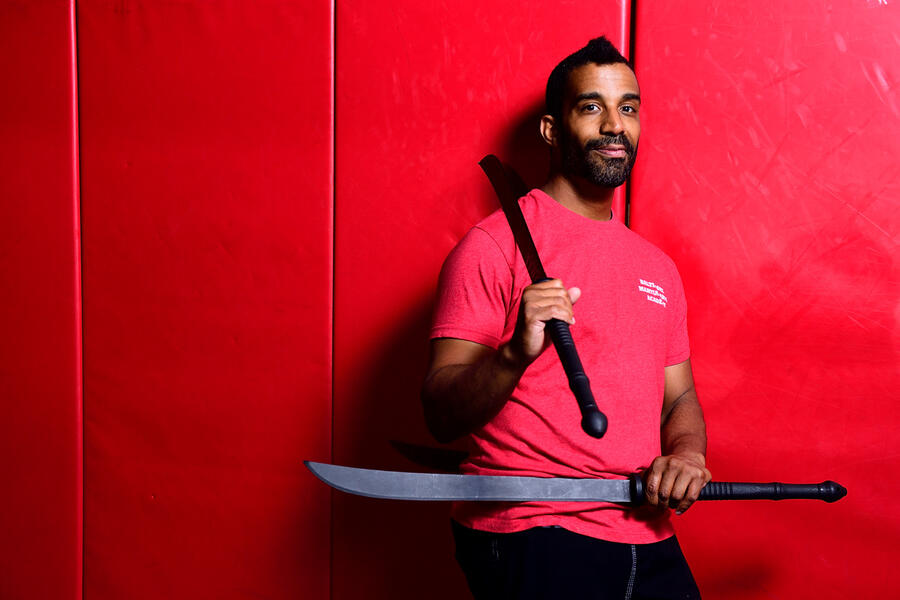My Other Life is an At Work series that lets us get to know our Johns Hopkins colleagues better. Do you, or does one of your co-workers, have a personal passion that would make a good story? Let us know at hubatwork@jhu.edu. Want to read more of the series? Go here.
It's no fun—and somewhat embarrassing—to execute a backflip and unintentionally "knee" yourself in the face, especially when a camera captures the whole thing. But Tariq Mansour knows how to deal with such mishaps to avoid serious harm. It's all in the training.
"Accidents happen, but we learn how to fall. This certainly was unfortunate, but it could have been a lot worse," he says. "One of my favorite Japanese proverbs is Fall down seven times, stand up eight."
During the work week Mansour often can be found on the other side of the camera as a multimedia producer for the Johns Hopkins University Carey Business School, where he is part of the Marketing and Communications team. He joined JHU 11 years ago. "I do mostly video interviews—testimonials from alumni, students, professors, and staff," he says.
But on many weekends he puts his years of martial arts training into "stunt fighting" for short action indie films, some of them available on YouTube.
This pastime began in 2018, after one of his friends told him about a stunt class in Rockville, Maryland, involving a group of locals made up of martial artists, actors, gymnasts, and dancers, "all from a movement or acting background who were trying to learn how to do basic movie stunts," he says.
"This is a group of people who are all passionate about 'fight choreography,'" he adds. "It's a mixture of pros and amateurs all learning from each other."
While participating there he met area directors and fight choreographers, including "local legend" Joseph Le, founder of Team Red Pro, who "went on to work on productions like Marvel's Shang-Chi, the Oscar-winning movie Everything Everywhere All at Once, and Disney's television series Ahsoka," he says.
Le was creating his own short action films to build his professional portfolio, Mansour says, and he and others in the group began appearing in Le's films. "None of us are making any money on these," Mansour says. "We are just doing it for the love of the game—meaning stunt fighting for fun. The dedication of Joseph and the coalition of people around him truly inspired me and still does till this day."
Most of the time Mansour's role in these films is "taking a fall," he says. "Because I know how to fall."
Still, that incident in 2019 gave him a hard knock, just above his eyes.
"I was getting hit with an uppercut and was supposed to do a backflip onto my stomach," he recalls. "Instead of going directly over, I leaned to the right and landed on my neck and upper back area and kneed myself in the face. My eyebrow took the worst of it, but I completely wrecked my neck for a while.
"It probably was the worst injury that's ever happened to me when doing a film, although not the only time I've been hurt," he adds. "We train hard for this—there is a lot of physical training with this because you can get hurt—but I was fine. You can walk away from it. One of the beauties of martial arts is that you are a lot more durable than you think."
Mansour began learning martial arts as a child and describes his expertise as being in "mixed" martial arts, having trained in numerous disciplines, including kung fu, Brazilian jiujitsu, Thai kickboxing, Filipino stick fighting, traditional karate, taekwondo, and wrestling. "You just take a little bit of the stuff that works and put it in context of what you need," he says.
The training gave him confidence and focus, particularly in childhood, he says. "I grew up with two brothers, and we were constantly fighting," he says. "We also loved Ninja Turtles and martial arts movies. My older brother practiced martial arts later in life—he and I did a kung fu class when I was in college—but my younger brother stopped because he lost interest." (He also has an older sister, who's never been inclined toward martial arts, he says.)
The discipline provides him with the certainty that he can defend himself if necessary, though he doesn't expect to face that challenge. "If I ever had to defend myself in a real-life situation, I would be very surprised," he says. "I really wouldn't want to engage with anyone because there are knives and guns out there. But it's a practice that keeps me centered. It balances me out."
In 2018 Mansour won silver and bronze medals in his division in the USA WEKAF (World Eskrima Kali Arnis Federation, the international sports body for the sport of arnis, a Filipino martial art) East Coast Qualifier.
For the past seven years he also has been teaching martial arts twice a week to young children and teens at the Baltimore Martial Arts Academy in Catonsville. "It's cool to give something back to the sport and the community," he says.
He never sought a belt level in any of the sports—that's not why he does it—"but to teach and practice and have the confidence to defend myself if necessary, although that hasn't been the case," he says. (In May 2025, however, he received—unexpectedly, he says—his first black belt, in Burmese bando boxing and naban.)
Mansour spent many of his early years abroad and describes his family as "expats," raised by an American mother—she is from Rhode Island and "was a bit of a hippie"—and a father from northern Sudan, who worked as a business consultant. He was born in Saudi Arabia and moved to Rhode Island when he was 4, then to Malta at age 7. "Both my parents were nomads—travelers—who met in Istanbul in the '70s," he says.
He also lived in Nairobi, where his mother worked as a housing coordinator for USAID, from age 11 to 22. He started his education at an American school in Nairobi, then moved to Baltimore and finished his studies at UMBC.
Initially he earned his way by waiting tables at a café and taking on small video and photo jobs. He also worked for six months "as a temp processing applications in the international department of Johns Hopkins Hospital before joining the business school full time. "One of my regulars at the café referred me after I graduated college," he says about how he landed at Carey.
While that misdirected backflip was his only calamity during filming, he has suffered his share of injuries when sparring with friends and training partners, he says. He's suffered broken toes, a dislocated rib, bloody noses "galore," busted lips, black eyes, and sprains to his shoulders and knees, he says.
"I have done terrible things to my body, but it's taught me that humans can take a lot and walk it off, and heal and come back stronger," he says. "People often have a fear of falling as they get older, but when you learn how to fall, you can worry less about that. I always bounce back because of my training—and the adrenaline is bar none. It's worth it because of the community and the fun—and it really is fun."
Posted in News+Info
Tagged my other life









